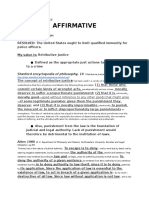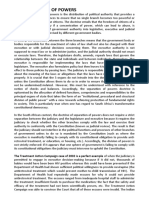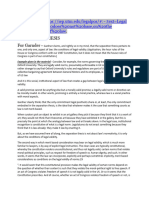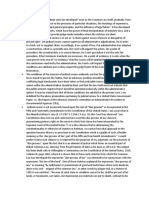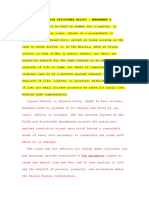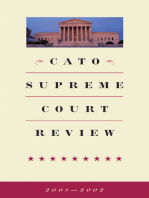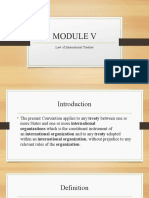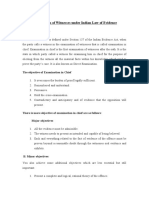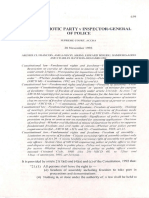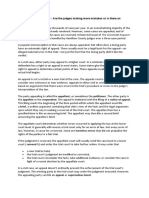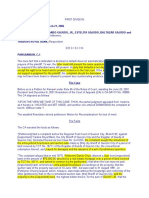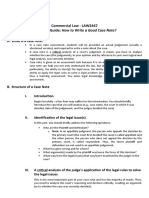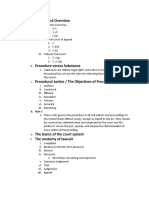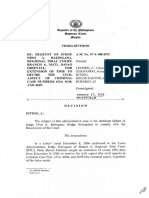‘Strict Scrutiny’ Test in Constitutional Adjudication: Indian Experience
The need of the judicial interpretation has ever existed and persisted in every legalsystem of the world. Initially the judges in their eagerness to avoid the blasphemy of judicial legislation bounded themselves with the rule of literal interpretation which ledto a number of absurd and inequitable results. Subsequently, in relation to theconstitutional adjudication, the role of judges enlarged from literal interpretation tointent based interpretation and finally to declaration in cases of vacant spaces.However it was the Supreme Court of the United States of America, one of the oldestconstitutional courts of the world, which bestowed upon itself the power of judicialreview ; it was this power which made courts the gatekeepers of fundamental rightsand provided for the power of a court to hold unconstitutional and henceunenforceable any law, official action based on a law, or any other action by a publicofficial, that it deems to be in conflict with the basic law, that is, the Constitution.In exercising the task of determining whether a violation is in fact justified the courtshave evolved, educed and applied various rules of interpretation. The courts in suchconstitutional adjudication where the fundamental rights infringement were involved provided that these issues deserve an intense review. Several new tests evolved as anoutcome of such need of intense review. One of the tests evoked and utilized by thecourt in such constitutional adjudication is in form of ‘Strict Scrutiny’ Test.This work emphasizes upon the meaning and genesis of ‘strict scrutiny’ test, elementsof ‘strict scrutiny’ test, application of ‘strict scrutiny’ test in USA, applicability of testin Indian Constitutional interpretation and approaches of the courts in this regardlastly it testifies the need of the test in Indian Constitutional framework.II.
‘Strict Scrutiny’ Test: Its Intendment, Provenance And Elements
“We seek not just freedom but opportunity—not just legal equity but human ability— not just equality as a right and a theory, but equality as a fact and as a result.”
(A) Intendment
When a government actor makes a decision that confers benefits or burdens based ona person’s status or membership in a particular group or class, e.g., race, gender, or
age, and that decision is challenged, the legality of the decision must be analyzedunder one of three levels of judicial scrutiny—strict, intermediate, or weak.Strict scrutiny test in its ingenuous form can be said to be a standard of judicial reviewfor a challenged policy in which the court presumes the policy to be invalid unless thegovernment can demonstrate a compelling interest to justify the policy. Strict scrutinytest is one of the tests amongst the three tests utilized by the US courts, the other twoas-(a) the rational basis test, which is the lowest form of judicial scrutiny used in caseswhere a plaintiff alleges that the legislature has made an arbitrary or irrationaldecision.(b) the heightened scrutiny test, which is used in cases involving matters of discrimination based on sex.According to Richard Fallon strict scrutiny test is a judicially crafted formula for implementing constitutional values which ranks among the most important doctrinalelements in constitutional law.Strict scrutiny test which evolved from the ‘preferred freedom’ test, which itself was arevitalized version of ‘clear and present danger’ test provided for a tripartite test asfollows-1. Where legislation or other statement of policy abridges a preferred freedom on itsface, the usual presumption of constitutionality is reversed; that is, the statute or other enactment is assumed to be unconstitutional, and that presumption can be overcomeonly when the government has successfully discharged its burden of proof.2. The government must show that the exercise of the fundamental right in questionconstitutes ‘a clear and present danger’ or that the legislation relating that libertyadvances ‘a compelling interest.’3. The legislation must be drawn in such a way as to present a precisely tailoredresponse to the problem and not burden basic liberty by its over breadth; that is, the policy adopted by the government must constitute the least restrictive alternative.According to Prof. John Ely, courts should strictly scrutinize statutes of the kind’smost likely to trigger suspect-content tests. He points out that given the Constitution’scentral commitment to political democracy, the crucial role of the courts is not to
second-guess the substantive decisions of the political branches but to ensure theintegrity of the democratic process.In applying the strict scrutiny to legislation containing suspect classification, the judges have used the above standards to judge laws infringing a preferred freedom. Astatute that explicitly discriminates on the basis of race, for example, is presumed to be unconstitutional. Government bears the burden of demonstrating that it hascompelling interest for distinguishing among citizen on that basis. It must also showthat no other basis for categorization in the law could serve that compelling interest aseffectively.Thus the term “strict scrutiny” refers to a test under which statutes will be pronouncedunconstitutional unless they are “necessary” or “narrowly drawn” or “closely tailored”to serve a “compelling governmental interest”.
(B) Provenance
According to Fallon the modern strict scrutiny test developed during the 1960s as aninnovation of Warren Courts. Before the 1960s, the idea had emerged that someconstitutional rights deserved more protection than others, or appropriately triggeredheightened judicial scrutiny, but no workable formula had emerged to implement thisgeneral idea, it was this need of workable formula that the strict scrutiny test wasevolved. Fallon writes that strict judicial scrutiny---which is a generic constitutionaldoctrine, capable of broad application---rose to prominence as the solution to ageneric problem confronting the Warren Court. That problem involved the judicialenforcement of a regime of “preferred” or fundamental rights that were too importantto be balanced away on an ad hoc basis or protected only by a rational basis test, onthe one hand, but that the Court thought it impractical to define as wholly categoricalor unyielding, on the other. The modern strict scrutiny test arose as a device toimplement, or as the constitutional complement to, a closely related phenomenon of more primary significance: the Supreme Court’s solidifying commitment to a jurisprudential distinction between ordinary rights and liberties, which thegovernment could regulate upon the showing of any rational justification, and morefundamental or “preferred” liberties entitled to more stringent judicial protection. Theevolution and development of the strict scrutiny test will be emphasized more whiledealing with the USA perspective.
(C) Elements
According to Siegel Strict scrutiny varies from ordinary scrutiny by imposing threehurdles on the government. It shifts the “burden of proof” to the government; itrequires the government to pursue a “compelling state interest;” and it demands thatthe regulation promoting the compelling interest be “narrowly tailored.” Thus, broadly there exist three elements of fulfillment in relation to strict scrutiny test whichare discussed herewith.(i) Burden of Proof: - Shifting the burden of proof is an expression of strict scrutiny’sassumption that in certain situations the judiciary should not accord the normal presumption of constitutionality to government action. The burden shifting aspect of strict scrutiny traces to the Supreme Court’s decision, in the late 1930s, to accordgovernmental action that burdened First Amendment liberties a reduced presumptionof constitutionality.(ii) Narrow Tailoring: - Narrow tailoring is the oldest branch of strict scrutiny.Tracing back to Gilded Age Commerce Clause adjudication, and frequently used inLochner-era police power cases, the “narrow tailoring” doctrine gave meaningful protection to constitutional norms well before the development of either bifurcatedreview or modern strict scrutiny. By 1940, the New Deal Court had made narrowtailoring analysis a prominent part of First Amendment jurisprudence. The WarrenCourt made it a part of equal protection analysis in 1964.Strict scrutiny’s “narrowtailoring” requirement provides a means to examine the government’s “precision of regulation,” allowing the Court to uphold government action “only if ... it is necessaryto achieve ... [the] compelling interest” that the government has asserted as the purpose of its action. Narrow tailoring demands that the fit between the government’saction and its asserted purpose be “as perfect as practicable.”Strict scrutiny’s narrowtailoring requirement means that in pursuing its goals, government action can beneither over- nor under-inclusive.(iii) Compelling State Interest: - Siegel emphasizes that a compelling state interest isone of the central tenets of modern constitutional law. It comes into play, whenever government employs a suspect classification, burdens a fundamental interest, or





